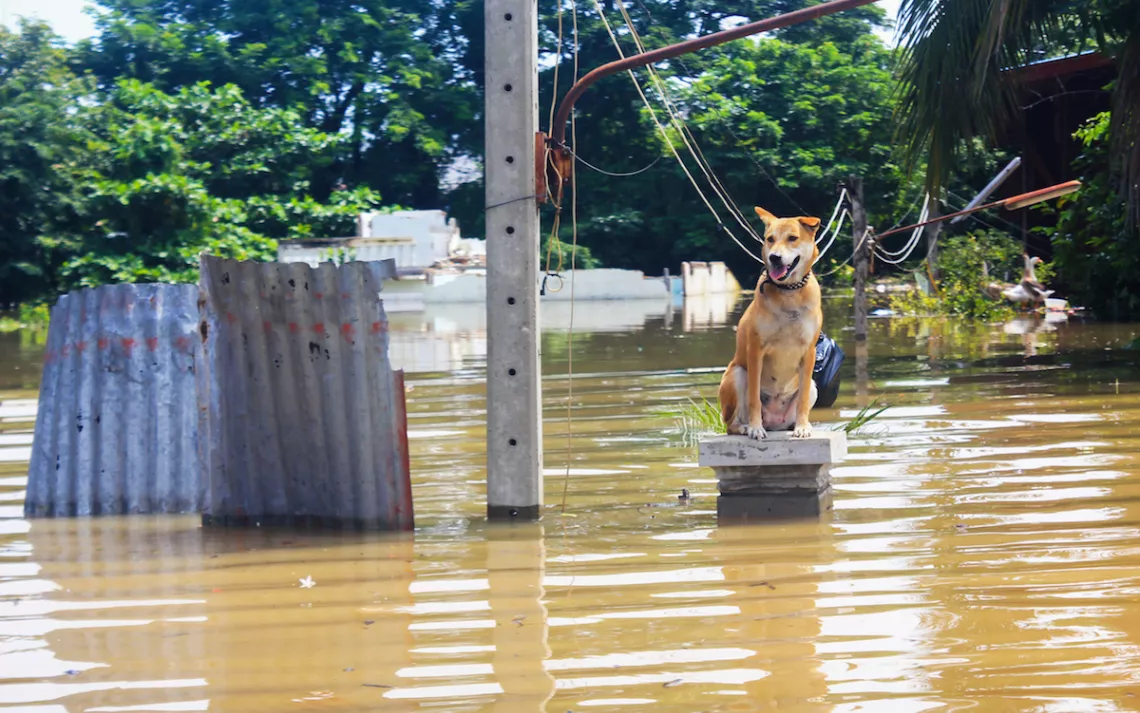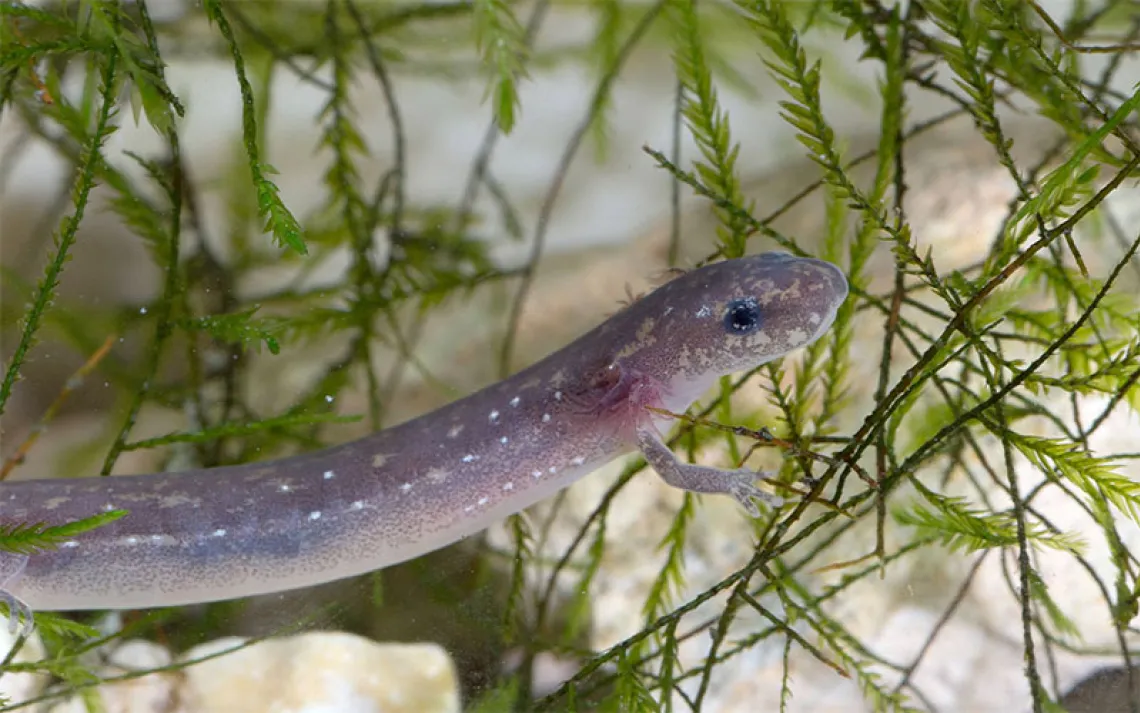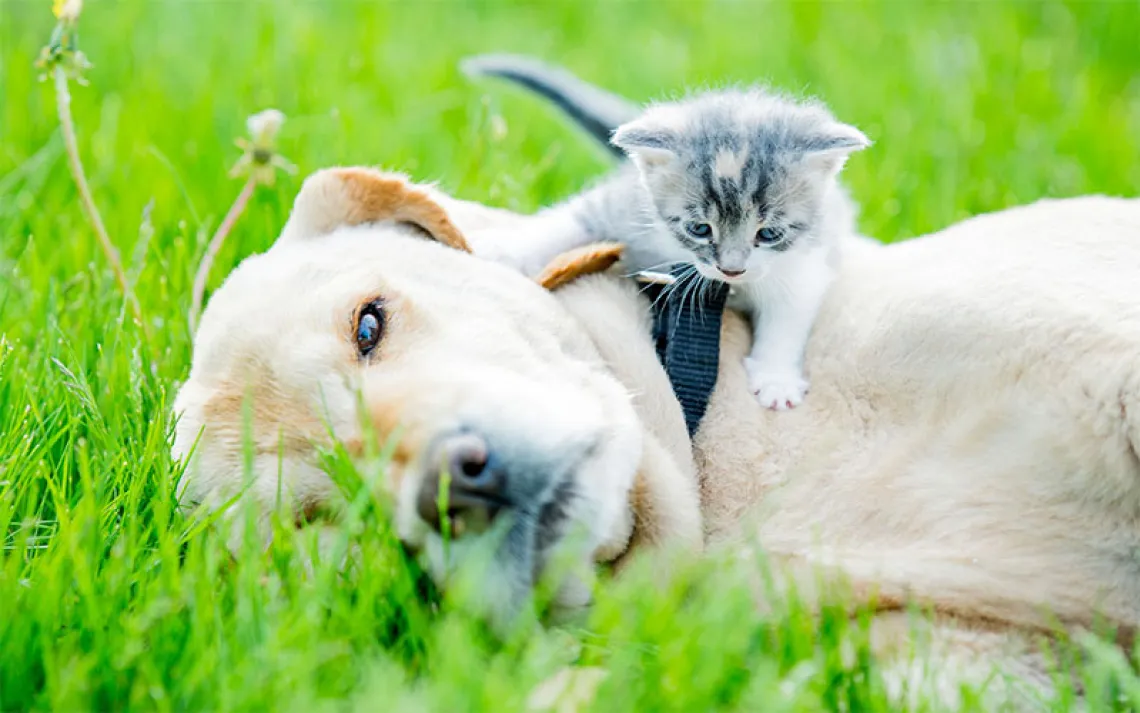What Happens to Animals During Natural Disasters?
Who’s saving pets and how—and ways to protect your animals
This article originally ran September 17, 2018, and has been updated since publication.

Sign up to receive Sierra News & Views
Get articles like this one sent directly to your inbox weekly.
With this action you affirm you want to receive Sierra Club communications and may vote on policy designated by the Sierra Club Board.
As Hurricane Florence delivered torrential rainfall and strong winds over the Carolinas in September 2018, many emergency workers mobilized with a single priority: saving animal lives.
“If we waited for confirmation that a disaster would go one way or another, we’d never be prepared,” says Richard Green, director of the disaster response team at the American Society for the Prevention of Cruelty to Animals (ASPCA), which carried out relief work in areas impacted by the hurricane. “You have to lean forward. If you’re not embedded and in position, animal lives will be lost.”
Late summer and early fall have become filled with anniversaries of recent natural disasters—events that have fundamentally shaped how federal and state governments incorporate pet relief into emergency planning. With each disaster, and often at the request of state governments, animal rescue teams head straight into the areas people are fleeing to ensure that few shelter animals, strays, and displaced pets are left behind.
When a hurricane, wildfire, tornado, or other disaster forces local shelters to close or evacuate, temporary pop-ups run by rescue organizations—and often housed in large parking lots or evacuated department stores—typically become the sole resource for pet owners needing to temporarily surrender their pets, for strays caught running for their lives, and for homeless shelter animals. Monica Frenden, director of Feline Lifesaving at Austin Pets Alive, was on the ground during Hurricane Harvey in 2017 and describes the mix of sadness and relief in owners who gave up their pets before fleeing. “Wherever there’s human devastation, there’s animal devastation. If people can’t get out, animals can’t get out.”
Some personnel at these emergency shelters are paid staff; most of the time, in addition to managing the animals and the crisis itself, they coordinate and train vast groups of volunteers to keep up with intakes that can exceed 200 per day. In the midst of the many wildfires that ravaged California in 2018, Ryan Darfler, director of the disaster response nonprofit MAD Dog Rescue, managed a team of less than a dozen trained staff and more than a hundred volunteers. Noting that this community support is crucial, Darfler says seasoned rescue staffers must quickly decide whose skills are best suited to various tasks. “When the adrenaline’s going, body language and behavior become important. You find those people who are really solid, and you put them on the right tasks.”
Naturally, preemptive planning is key to managing a 24-hour emergency shelter. Once an emergency shelter’s central command post is established, animal rescuers typically start contacting municipal and county shelters in impacted areas, offering to absorb their animals, and for an important reason: Shelter staff may have no choice but to euthanize their charges, to spare them painful deaths due to the disaster at hand, or to make room for new animals coming in from the devastation.
Even before Hurricane Florence descended, the Humane Society of the United States was one among several national rescue organizations helping to clear out local shelters in advance. “We’ve been doing preemptive evacuations,” says Wanda Merling, deputy director of animal rescue team operations, who’s presently deployed in South Carolina. “[We’re] clearing out shelters that are located out of harm’s way so they can serve as a hub for the incoming rescue animals.” During Hurricane Harvey, Austin Pets Alive called shelters in the path of the storm in an effort to prevent euthanizations. “When shelters know they have to evacuate, they have to cull their population,” Frenden says. “We were sending vans and trucks down to shelters before Harvey even hit and stocked up on cats and dogs from the coastal areas.”
In addition to transporting animals to shelters and foster homes out of harm’s way, disaster rescue operations present an overwhelming amount of tasks: search-and-rescue missions, receiving pet surrenders, and providing emergency medical care. The former involves first responders who seek out animals abandoned by fleeing owners or strays desperate for a life-saving hand—often risking their lives to search through fires, contaminated flood waters, toxic lava smoke, and sometimes, even alligator colonies, as Austin Pets Alive did during Hurricane Harvey. “It was life-changing time for me,” says Marc Peralta, the senior director of National No Kill Advancement at Best Friends Animal Society, who landed in Houston to coordinate rescue operations just after Hurricane Harvey hit. “I’d never been in a situation like that, but we work in shelters that are always overflowing at every moment, so it can kind of feel like a disaster situation every day. A lot of that fed into the situation [in Houston] and how we were going to help.”
In the aftermath of a disaster, animals on the streets are often spooked and full of adrenaline. “Animals were tied to trees [after Harvey hit],” Frenden says. “Cats were floating on trash cans down the road. Cats, dogs, horses, chickens, pigs, you name it.” Once rescued, animals are transferred to evacuation centers and treated by volunteer veterinarians. Sickness, infection, and disease are disasters-within-disasters that can make the difference between a few lives lost and hundreds. “We took in the biggest wave of injured or sick animals,” Frenden says, “including a cat who swam through a fire ant colony and had burns all over her body from trying to get to higher ground. We took lots of parvo pups, and kittens with ringworm. It was controlled chaos.”
Hurricanes’ toxic, contaminated flood waters leave animals particularly susceptible to long-term diseases. “If you’ve ever been through a flood, it’s disgusting,” Peralta says. “There’s disease, and humidity.” The most common deadly disease found in the wake of natural disasters is distemper (panleukopenia in cats), an airborne virus that attacks animals’ respiratory, gastrointestinal, and central nervous systems. “[Distemper] really prolonged our stay [after Harvey],” Peralta says. “We had to make sure the animals weren’t just disease-free, but also not still carrying the virus.” Of the dogs Best Friends rescued, 116 tested positive for distemper, as did thousands of cats rescued by Austin Pets Alive. There is no cure for distemper: infected animals must be treated with fluids and anti-seizure and anti-nausea medications by the hour until it abates—and it’s usually fatal for kittens, puppies, and animals with pre-existing illnesses. After Harvey, partnerships among rescue organizations’ regional chapters saved many lives: Charlottesville-Albemarle SPCA in Alabama took in dozens of distemper- and ringworm-positive dogs, and Austin Pets Alive relied on a robust foster network to house animals in recovery.
During natural disasters, partnering with fellow rescue organizations is essential—no one operation can single-handedly juggle logistics, as staff are typically unfamiliar with local resources. Strategic partners and fosters create a pipeline for supplies, temporary homes, and trained staff support. For multiple groups handling one area, constant communication ensures that rescue operations aren’t duplicated or mishandled, and that owner documentation remains tracked. “When a city is overflowing,” says Peralta, “it’s not the most conducive environment to innovate and try new things, so partnerships are really key.”
One of the reasons animal rescuers partner and network so efficiently these days? Lessons learned from Hurricane Katrina. That response effort, which was marred by chaotic shelter disorganization, a lack of government support, and the large-scale displacement of pets, is routinely described as a watershed moment within the animal rescue community.
Richard Green, who has worked on more than a hundred rescue missions with the ASPCA, describes the difference between pre- and post-Katrina emergency response: “[The animal rescue community] walked away from that beat up, because we didn’t understand the basic concepts of large-scale incident management. We knew how to rescue animals, but not to organize ourselves as effectively—and couple that with very little to no state or federal support. Today, it’s a completely different environment. We have tremendous coordination between the federal and state level.” For instance, states now have Memorandums of Understanding with national animal rescues like ASPCA and the Humane Society, which allows rescue teams to utilize government aid and to work with emergency responders to access impacted areas.
Ryan Darfler of MAD Dog recounts the logistical chaos of displaced Katrina pets. “What happened was, [animal rescues] just said, ‘Get these animals out of here, buy one-way tickets to anywhere outside of New Orleans,’ which was totally flooded.” Pet owners were left never learning whether their animals were alive or misplaced, and shelters around the country were flooded with rootless pets. “Nobody [at shelters] knew if they were pets or strays. A lot of them got adopted out. A lot of owners lost animals. So, there was a huge lesson learned from that. It reverberated throughout the entire shelter and rescue community. Now, everyone is extremely diligent.” As a result, Darfler says, rescued animals are now rigorously documented; owners claiming pets are thoroughly vetted before being able to take an animal from a shelter, and animals are not transported elsewhere for adoption until every effort at finding an owner is made.
Those best practices have been honed again and again in the years since Katrina—rescues readily cite climate change as the cause of the increase in their national emergency response deployment. “We’re seeing an uptick in federally declared disasters,” says Green. After the ASPCA was deployed to six states and the U.S. Virgin Islands to rescue 37,000 animals impacted by natural disasters in 2017, Green argued that climate change was increasing the need to bolster animal evacuation strategies in the United States. He says, “These fires and floods are increasing in a nonlinear fashion. It’s just going to become more and more difficult. [The government] has to be smarter about the way that we manage disasters, because there’s limited funding, greater population numbers, and more people moving to the coasts, where climate change has a bigger impact.” In 2009, the Humane Society of the United States and Humane Society International released a statement warning of massive animal displacement due to climate change, and in 2011 its magazine, All Animals, published a feature examining the effects of climate change on global wildlife.
But as long as natural disasters keep occurring, rescuers say, they will be on the front lines to save animal lives and fight to keep human and animal families together.
How should pet owners prepare for a natural disaster?
Evacuate as soon as a mandatory or voluntary order is given. “If you get a warning that you need to evacuate, don’t be that person who stays behind,” says Green. “I see it every day. Just heed the advice and evacuate. Many of the things you’d do for your family, you’d do for your pets, and they are your family, so take the extra steps and do it.”
Microchip your pets, and keep your contact information current. Every rescue organization interviewed for this article cited missed opportunities to reunite pets with owners after disasters due to lack of microchips or outdated microchip information, like nonworking telephone numbers.
Keep a leash and/or transport carrier in your car or by your door. Rescuers acknowledge that this is tricky depending on the animal. For cats, who must be in a contained environment lest they bolt into an inaccessible place or dart dangerously around a moving car, a pillowcase or collapsible cardboard carrier is safe, comfortable, and portable, and keeps your hands free.
For large ranch animals, like horses or cattle, use a clip-on ID tag. Known as I.C.E. tags, identifiers can easily be clipped onto a horse’s mane or bridle, or onto cattle ears. That way, if the animals must be let loose, they can be caught without being mistakenly transported to distant ranches.
Most important: Make a plan, any plan, of where you can go outside your immediate area and determine how you would transport you and your pet there. “Doesn't have to be written out or complicated; just come up with an idea,” says Darfler. “What are you going to do if you’re at work and a disaster happens? That way, when you have tunnel vision once a disaster hits, with the adrenaline going, you can remember that plan you already thought of. That’s the reason all these first responders rehearse so much—the military, police, firefighters, paramedics, nurses. It builds memory muscle, so that when you can’t think in an emergency, you revert back to that plan you already thought of.”
 The Magazine of The Sierra Club
The Magazine of The Sierra Club




